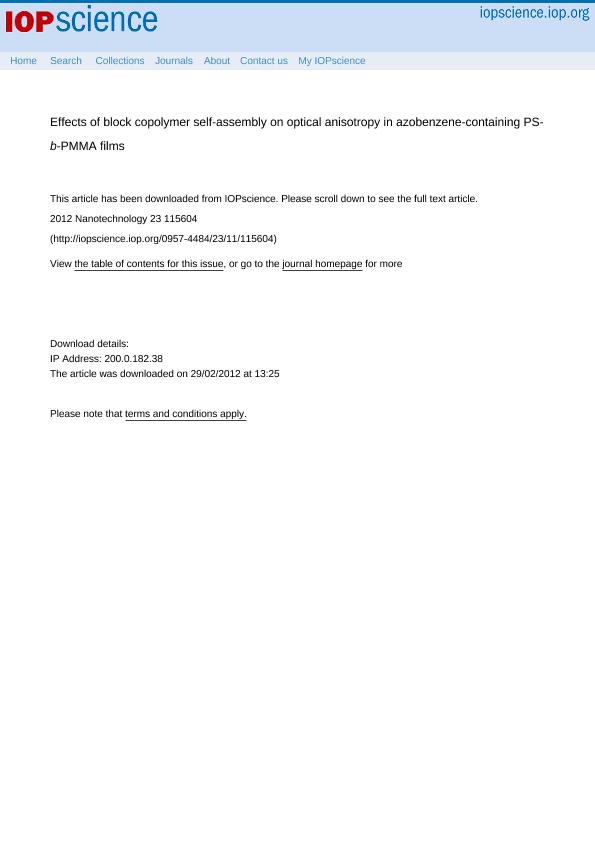Artículo
Effects of block copolymer self-assembly on optical anisotropy in azobenzene-containing PS-b-PMMA films
Orofino, Antonela Beatriz ; Camezzana, Maria Florencia; Galante, Maria Jose
; Camezzana, Maria Florencia; Galante, Maria Jose ; Oyanguren, Patricia Angelica
; Oyanguren, Patricia Angelica ; Zucchi, Ileana Alicia
; Zucchi, Ileana Alicia
 ; Camezzana, Maria Florencia; Galante, Maria Jose
; Camezzana, Maria Florencia; Galante, Maria Jose ; Oyanguren, Patricia Angelica
; Oyanguren, Patricia Angelica ; Zucchi, Ileana Alicia
; Zucchi, Ileana Alicia
Fecha de publicación:
03/2012
Editorial:
IOP Publishing
Revista:
Nanotechnology
ISSN:
0957-4484
Idioma:
Inglés
Tipo de recurso:
Artículo publicado
Clasificación temática:
Resumen
Polystyrene-b-polymethylmethacrylate (PS-b-PMMA) was selected as the host for 4-(4-nitrophenylazo)aniline (Disperse Orange 3, DO3) based on a previous study of DO3/PMMA and DO3/PS binary blends. Selective location of DO3 into the PMMA block of the copolymer was expected during self-assembly of the block copolymer since a preferential interaction of DO3 with PMMA has been demonstrated. However, surface segregation of DO3 was found during the thermal annealing used to nanostructure the copolymer. To avoid this, a thermoplastic polymer (Azo-TP) was synthesized from the bulk reaction of DO3 and diglycidyl ether of bisphenol A (DGEBA). The choice of DGEBA as a co-reactant was an attempt to encourage the selective location of azo groups in the PMMA phase of PS-b-PMMA. An inspection of solutions of Azo-TP in PS and PMMA, corroborates the preferential affinity of Azo-TP for PMMA. The Azo-TP could be satisfactorily dissolved in PS-b-PMMA. We have investigated the growth and decay processes of the optically induced birefringence in films of PS-b-PMMA containing 12wt% Azo-TP. The resulting materials showed a good photoinduced time response, high maximum birefringence and an elevated fraction of remnant anisotropy.
Palabras clave:
Block Copolymer
,
Azobenzene
,
Optical Anisotropy
Archivos asociados
Licencia
Identificadores
Colecciones
Articulos(INTEMA)
Articulos de INST.DE INV.EN CIENCIA Y TECNOL.MATERIALES (I)
Articulos de INST.DE INV.EN CIENCIA Y TECNOL.MATERIALES (I)
Citación
Orofino, Antonela Beatriz; Camezzana, Maria Florencia; Galante, Maria Jose; Oyanguren, Patricia Angelica; Zucchi, Ileana Alicia; Effects of block copolymer self-assembly on optical anisotropy in azobenzene-containing PS-b-PMMA films; IOP Publishing; Nanotechnology; 23; 11; 3-2012
Compartir
Altmétricas



